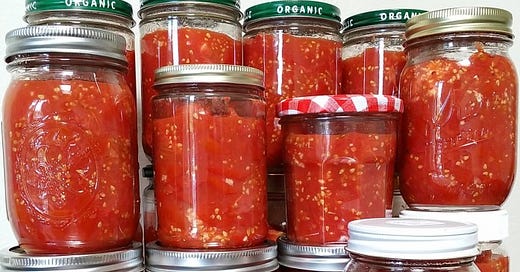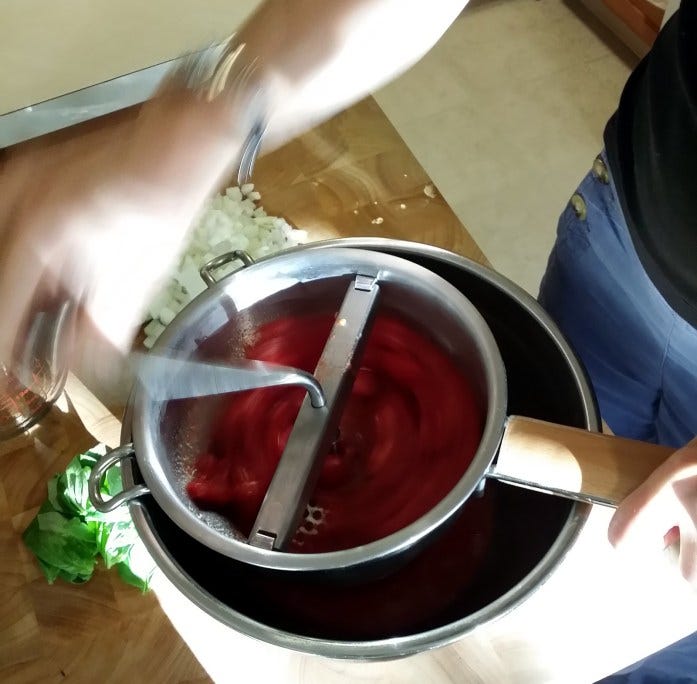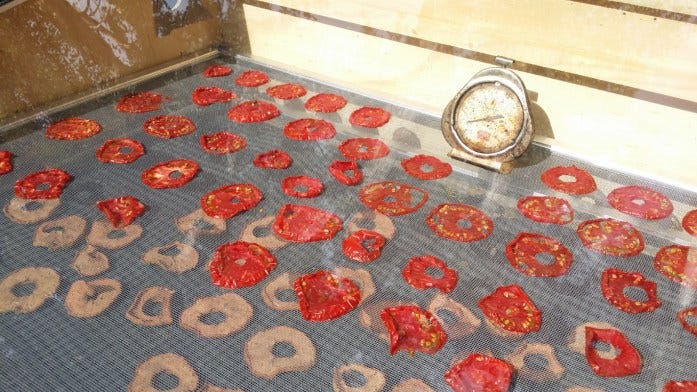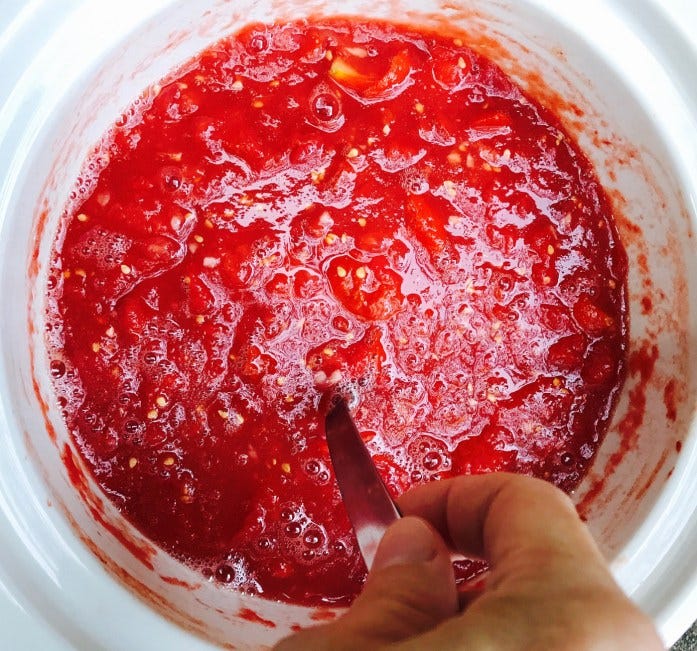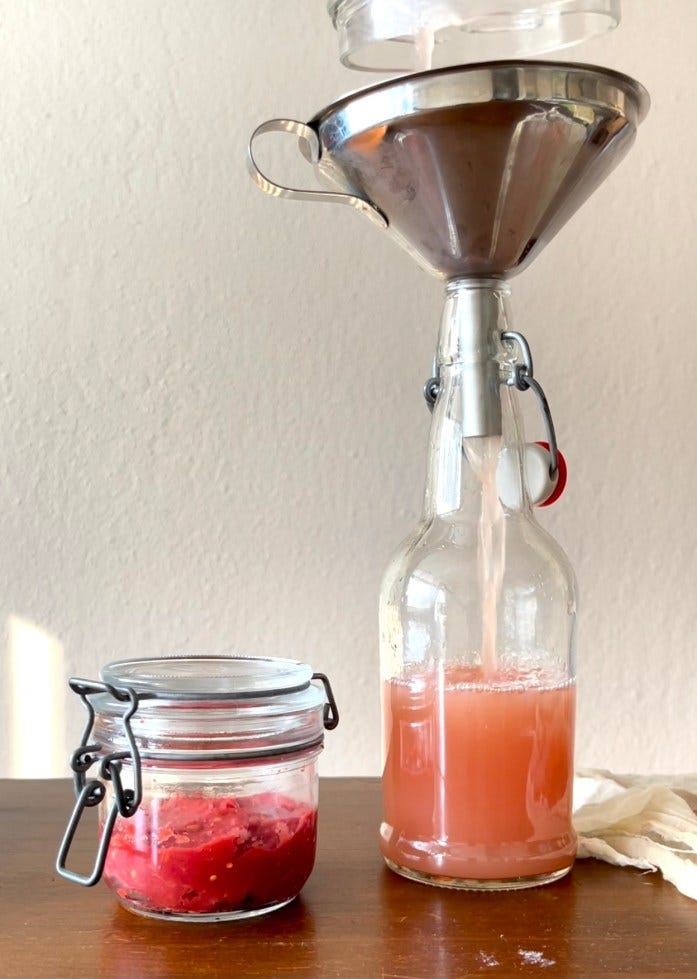If you have planted a vegetable garden, you may have begun to experience what-am-I-going-to-do-with-this-glut-of-tomatoes syndrome. Mild symptoms such as the urge to search for dozens of free canning jars begin in early August and can intensify within a couple of weeks from feelings of dread for planting so many tomatoes, to paralysis to do anything with your harvest, including harvesting it.
The following ideas will help alleviate this summertime condition.
1. Roasted tomatoes
One of the first questions I hear from people when they find out I don’t buy canned food is “What do you do for tomatoes?” I used to buy cans and cans of tomatoes for chili, pasta and pizza sauce and many other recipes until I went plastic-free in 2011. I replaced those cans with these roasted tomatoes. They taste much better.
At the end of summer, when the prices have dropped, I buy three or four 20-pound cases of dry-farmed Early Girls from Tomatero Farm at the farmers’ market.
Here’s what I do: Halve or quarter tomatoes into bite-size pieces (Early Girls are small), spread them out on rimmed cookie sheets, top some trays with crushed garlic if desired, roast at 225F to 250F for an hour and a half or so until soft, allow to cool, fill wide-mouth glass jars (but leave headspace) and freeze.
Here’s the detailed post on roasted tomatoes.
Once you have roasted the tomatoes, use them in the following three recipes (and many others).
2. Pizza sauce
You will not be able to eat store-bought pizza sauce after you’ve tasted this. It’s so easy to make too. Just sauté some minced garlic, add chopped fresh tomatoes (or a smaller amount of roasted tomatoes), salt and spices and cook down for about 10 minutes (depending on how juicy your tomatoes are). This freezes well.
Go here for the pizza sauce recipe.
3. Tomato sauce
This works best if you run the tomatoes through a food mill to remove the skins. If you grow piles of tomatoes, you may want to invest in a food mill. This recipe also freezes well.
Go here for the tomato sauce recipe.
4. Vodka sauce
The first time my daughter MK made this, I couldn’t believe my tastebuds. Vodka and heavy cream render a rich, velvety sauce. You could serve this to guests for a special occasion—it tastes that good.
In a perfect world, I would always run the roasted tomatoes through a food mill before making this but I sometimes skip that step if I’m in a hurry. It still tastes good but if you have the time—and the food mill—I’d recommend using it. You can also blanch and peel tomatoes instead.
Go here for the vodka sauce recipe.
5. Dehydrated tomatoes
I have made these in a solar dehydrator that reaches temperatures up to 225°F. Slice the tomatoes, spread them out in the dehydrator that sits in the sun, rotate the dehydrator occasionally for optimum rays and wait. The tomatoes taste like candy. Once completely dried out, store the tomatoes in jars in the cupboard.
I realize most people don’t have a solar food dehydrator lying around. You can also dehydrate tomatoes in the oven. You can even use your car windshield, which I did during a heatwave last year. Dehydrate them in sauce, soup or even water for whatever you’re making. I know a woman who grinds her dehydrated tomatoes up to render tomato powder that she uses to rehydrate for her tomato dishes.
Go here for more on solar dehydrated tomatoes.
6. Fermented salsa
This is a very popular recipe on my blog and for good reason. It has a natural tang, a slight effervescence and tastes intensely fresh. To make this, you chop up salsa ingredients as per usual, but after stuffing them into jars, leave them out on the counter and wait a couple of days for them to ferment. The recipe calls for whey that you can omit if you’re vegan or if you simply don’t want to mix whey with vegetables. It will still ferment. You really can’t stop food from fermenting.
7. Fermented tomatoes
Like the salsa, these taste delicious and tangy. You cut up tomatoes into bite-size pieces, crush them up with your clean hands, stir in salt, cover, stir daily and wait several days for them to ferment.
When they have fermented, you can make quick pasta sauce out of them. Just heat in a pot to reduce the liquid. Stir in minced basil near the end if desired. Don’t add additional salt. Heat will kill off the beneficial microbes but the sauce tastes delicious and requires little energy or hands-on work.
Go here for the fermented tomatoes recipe.
8. Bloody Mary
Once you’ve fermented your tomatoes, you can use them to make a Bloody Mary without the Bloody Mary mix or the V-8 juice. Just puree the tomatoes, pour some in a glass and add vodka and the fixings.
Go here for the Bloody Mary recipe.
9. Cultured tomato juice
This stuff tastes fabulous! I think it would make a great base for the Bloody Mary above but I haven’t tried that yet. Once you have fermented the tomatoes, strain them to render this tomato juice and cultured tomato paste (#10).
Go here for the 2-ingredient cultured tomato juice recipe.
10. Cultured tomato paste
After a day of straining the juice above, you’ll also make tomato paste. I plan on cooking Spanish rice today with mine. Yum!
Go here for the 2-ingredient cultured tomato paste recipe.
You’ll find more tomato-based recipes in my cookbook, such as fermented ketchup, huevos rancheros, roasted tomato paste, tomato-based soup and more.
A timely and much needed resource. We love the way Anne-Marie gives us manageable, actionable steps so that we can waste less in our own day-to-day lives.”
— Tracy, Dana, Lori, and Corky Pollan, New York Times bestselling authors of Mostly Plants

